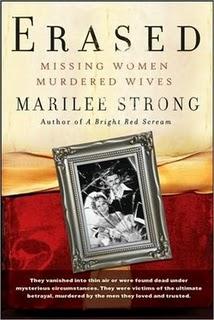Erased: Missing Women, Murdered Wives

When a crime is committed, the public wants to know why. In Erased, journalist Marilee Strong answers that question for a specific set of criminals she calls “eraser killers.” She outlines an in-depth profile of these killers hoping that the more the public knows about them, the more they will be caught and justice will be brought to their victims.
Strong started the journey to Erased while reporting on the disappearance of a pregnant woman in California named Laci Peterson. She covered Laci’s story through her disappearance to the conviction of her husband, Scott, for her murder and the murder of their unborn child. While researching other murders for the Peterson case, Strong noticed a psychological pattern between Scott and another killer who committed a strikingly similar crime more than fifty years earlier. This book is the result of the next five years of Strong’s research.
Erased covers more than fifty murders throughout the past century that fit the pattern of eraser killings, a form of intimate partner homicide that is committed almost exclusively by men, done in a carefully planned manner, which is often through bloodless means, in order to leave behind as little evidence as possible. The killers frame the murder to make it look like something happened that had nothing to do with them, and often try to make the body physically disappear as well. Eraser killers eliminate women, and sometimes children, in their lives simply because they no longer serve any purpose to them. The killers have no emotional attachment to their victims, considering them nothing more than a commodity. Most disturbingly, these men are often described as loving husbands right up until they day they kill. The women in their lives have no idea they are in danger until it is too late.
Strong credits the “unique psychology of men” with these murders and, in particular, a set of dangerous traits that psychologists have named the “Dark Triad” of personality: psychopathy, narcissism, and Machiavellianism. These traits lead eraser killers to believe they can literally get away with murder without anyone ever knowing. Ironically, it is also these traits that lead many to their downfall. Eraser killers can be so over confident that they make mistakes and overlook important details.
While it is interesting to know just where some of these killers went wrong, Strong occasionally takes those details too far. Her recounting of Laci Peterson’s murder becomes eerie when Strong describes exactly what Scott might have done to get away with it. Surprisingly, she goes into these specifics after telling the reader that many of these killers learn from each other as models, noting what worked for other killers and what pitfalls to avoid. With this in mind, many of the details Strong uses in Erased become uncomfortable to read. It makes one wonder how helpful the book is in bringing victims justice, and how helpful it could potentially be to a future eraser killer.
While Erased is disturbing on many levels, it is also thought provoking. For the majority of the book, Strong’s heart seems to be in the right place. In the conclusion, she offers recommendations on what the criminal justice system can do to better catch eraser killers. She focuses on closing loopholes that make eraser killers think they can get away with murder and that allow some of them to do just that. At the very least, Erased is a wake-up call that there is another, more disturbing, side to domestic homicide that deserves serious attention. Strong makes a very clear case that her profile and recommendations are worth considering.